![[Life of Aesop: Aesop taken to prison.]](img-thumbnail/jpegs/48710.jpg)
[Life of Aesop: Aesop taken to prison.] [How vaine are mens designes...]
Tho: Dudley fecit [after Francis Barlow.]
[Amsterdam: Etiènne Roger, 1714.]
Proof etching. Sheet 205 x 165mm (8 x 6½") Trimmed within plate, mounted on album paper.
Having found treasure for Xanthus, Xanthus still orders Aesop to be imprisoned. Aesop complains of the bad faith and is released. Plate 14 of thirty-one illustrations added to the second edition of Barlow's "Æsop's Fables, With His Life" (1687), to illustrate the translation of Planudes's Life of Aesop, which was unillustrated in the first edition of 1666. This example comes from an Amsterdam edition, 'Les Fables d'Esope', with the printing plate trimmed down. All of the plates were designed by Barlow: they were etched c.1678-9, only five by Barlow; the rest, including this one, by Thomas Dudley. Originally the plate extended down with a title verse (possibly written by Aphra Behn, who wrote new verses for the fables), but for this non-English edition the verse was trimmed off and new borders engraved. Little is known of Dudley: on one plate of this series he signed himself as a student of Wenceslaus Hollar; and in 1679 he went to Lisbon, where he is known to have made further prints, and he is not supposed to have returned to England thereafter. He etched some portraits but these prints after Barlow are his most important work. BM: 1871,0812.247, described as a proof state.
[Ref: 48710] £95.00
(£114.00 incl.VAT)
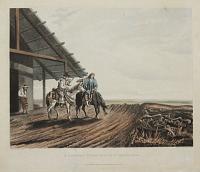
A Country Public House & Travellers.
E.E. Vidal, Esq. del.t. G. Maile & J. Bluck sculp.t.
London. Published Oct.r 1st 1820 at R. Ackermann's, 101 Strand.
Aquatint, printed in colours & hand finished. 255 x 305mm (10 x 12"). Repairs in inscription area and bottom margin.
A 'Pulperia', one five leagues south-west from Buenos Aires, which are described by Vidal as being 'most miserable, dirty hovels, where may be bought a little canna, or spirit distilled from sugarcane'. He writes that horses are so cheap, 'three dollars, the cost of two or three days keep in the city', that they are abused and then abandoned, accounting for the skeleton bottom right. From Emeric Essex Vidal's ''Picturesque Illustrations of Buenos Ayres and Monte Video'', one of the earliest descriptions of Argentinian life. Born c. 1788, Vidal entered the Navy in 1808 and retired in 1862. He visited Buenos Aires and Montevideo twice at the end of 1816 (the year Argentina became independent), returning 1828-9. He was stationed on St Helena 1820-1, during Bonaparte's exile. Abbey Travel: 698. Vidal's text is available on Google Books.
[Ref: 45755] £120.00
(£144.00 incl.VAT)

The Royal Charlotte Auricula.
Printed for Carington Bowles, N.o 69 in St Pauls Church Yard, London.
Fine & very rare mezzotint. 355 x 245mm (14 x 9¾"). False margins added. A tiny amount of time staining in the publication line.
A fantastic image. Still life of a pink primula auricula in a plant pot. A bird, likely a bullfinch, perches on the lip of the pot and a butterfly, possibly a monarch, sits on the leaves. Gordon Dunthorne Flower and Fruit Prints p223.
[Ref: 54818] £1,800.00
![[Still-life banquet piece]](img-thumbnail/jpegs/45998.jpg)
[Still-life banquet piece]
[?Robert Robinson, c.1680]
Fine mezzotint, sheet 240 x 190mm (9½ x 7½"). Trimmed to image (possibly losing text beneath image); false margins added on album sheet.
Food and drink (including game, grapes and other fruit) on a covered table. Probably engraved by painter and engraver Robert Robinson (fl.1674-d.1706). Robinson is chiefly remembered for early mezzotints such as this, while the most notable of his surviving paintings are the panels he painted for a house on St Botolph Street in the City of London, now housed at the Sir John Cass School in Aldgate. See Ref: 40220
[Ref: 45998] £220.00
(£264.00 incl.VAT)
![[Still-life banquet piece]](img-thumbnail/jpegs/40220.jpg)
[Still-life banquet piece]
I Beckett ex [illegible traces of effaced inscription, lower right]
Mezzotint, platemark 240 x 185mm (9½ x 7¼"), with very large margins. 19th century impression on wove paper.
Crabs and prawns on a platter on a covered table; grapes, peaches, an open melon, plums and a lemon behind; silver tobacco jar upper left. Mezzotint by painter and engraver Robert Robinson (fl.1674-d.1706). Robinson is chiefly remembered for early mezzotints such as this, while the most notable of his surviving paintings are the panels he painted for a house on St Botolph Street in the City of London, now housed at the Sir John Cass School in Aldgate. State ii/ii (Christopher Lennox-Boyd database).
[Ref: 40220] £130.00
(£156.00 incl.VAT)

Mrs. Aphara Behn. Aphara Behn, a celebrated wit and Dramatic writer of the reign of Charles II, was the daughter of Mr. Johnson, a Gentleman of a good family at Canterbury. Her acquaintance with the celebrated American Prince Oroonoko, whose adventures she was related, gave Southerne the first hint for his much admired play. Besides the above, she wrote several Histories and Novels, seventeen different Dramas, and published three Volumes of miscellaneous poetry, together with various translations. Her writings as well as her manner, were tinctured with the licentiousness of the reign in which she lived. She died April 16.th 1689, and was buried in the Cloisters of Westminster Abbey.
London. Published by Rob.t Wilkinson, 58, Cornhill. [n.d. c.1790.]
A very rare mezzotint with etching. Plate 180 x 120mm (7 x 4¾"). Trimmed to plate on right.
Aphra [Aphara] Behn (1640-1689) was a prolific dramatist of the English Restoration and was one of the first English professional female writers. Details of her life are scant, mainly because she was the main source: although there is evidence of her being the daughter of a barber, she suggested that she was daughter of the lieutenant general of Surinam, that country being the setting for one of her most famous works, 'Oroonoko'. Around 1664 she may have married Johan Behn, but he disappeared from her life almost immediately. Having been introduced to court about that time, she was employed as a spy by Charles II in Antwerp during the Second Anglo-Dutch War, seeking out English republican exiles. As a playwright she was mocked for her bawdy themes, including same-sex love between women. However she still earned a grave in Westminster Abbey (described as 'most scandalously but rather appropriately' by Virginia Wolff), although not in Poets' Corner.
[Ref: 42176] £160.00
(£192.00 incl.VAT)

Mrs. Aphara Behn. Aphara Behn, a celebrated wit and Dramatic writer of the reign of Charles II, was the daughter of Mr. Johnson, a Gentleman of a good family at Canterbury. Her acquaintance with the celebrated American Prince Oroonoko, whose adventures she was related, gave Southerne the first hint for his much admired play. Besides the above, she wrote several Histories and Novels, seventeen different Dramas, and published three Volumes of miscellaneous poetry, together with various translations. Her writings as well as her manner, were tinctured with the licentiousness of the reign in which she lived. She died April 16.th 1689, and was buried in the Cloisters of Westminster Abbey.
London. Published by Rob.t Wilkinson, 58, Cornhill. [n.d. c.1790.]
A very rare mezzotint with etching. Plate 178 x 121mm (7 x 4¾"). Trimmed to the plate; crease.
Aphra [Aphara] Behn (1640-1689) was a prolific dramatist of the English Restoration and was one of the first English professional female writers. Details of her life are scant, mainly because she was the main source: although there is evidence of her being the daughter of a barber, she suggested that she was daughter of the lieutenant general of Surinam, that country being the setting for one of her most famous works, 'Oroonoko'. Around 1664 she may have married Johan Behn, but he disappeared from her life almost immediately. Having been introduced to court about that time, she was employed as a spy by Charles II in Antwerp during the Second Anglo-Dutch War, seeking out English republican exiles. As a playwright she was mocked for her bawdy themes, including same-sex love between women. However she still earned a grave in Westminster Abbey (described as 'most scandalously but rather appropriately' by Virginia Wolff), although not in Poets' Corner.
[Ref: 20928] £160.00
(£192.00 incl.VAT)

Désespoir de Mris. Bellamy sur les marches du Pont de Westminster.
La Ville fe. Benoist del. F. Maradan sculp.
[n.d., c.1810.]
Engraving, 190 x 133mm.
George Anne Bellamy (1731? - 1788), actress. Initially her beauty and social reputation stood her in good stead. She was small in stature, fair, with blue eyes, and apparently very beautiful. During her early life she was thrown into intimacy with Fox and many characters of highest mark. Her later years were burdened with suffering and debt however. She describes herself on her reappearance in Dublin, when still little more than thirty, as ‘a little dirty creature bent nearly double, enfeebled by fatigue, her countenance tinged with jaundice, and in every respect the reverse of a person who could make the least pretension to beauty.’ Ex: Collection of Alec Clunes.
[Ref: 7882] £130.00
(£156.00 incl.VAT)
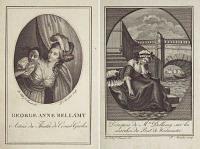
George Anne Bellamy. Atrice du Theatre de Covent Garden. [&] Désespoir de Mris. Bellamy sur les marches du Pont de Westminster.
La Ville fe. Benoist del. F. Maradan sculp.
[n.d., c.1810.]
Rare pair of stipple engravings, plate 190 x 135mm (7½ x 5¼") Torn within plate, surface dirt and time staining.
George Anne Bellamy (1731? - 1788), actress. Initially her beauty and social reputation stood her in good stead. She was small in stature, fair, with blue eyes, and apparently very beautiful. During her early life she was thrown into intimacy with Fox and many characters of highest mark. Her later years were burdened with suffering and debt however. She describes herself on her reappearance in Dublin, when still little more than thirty, as ‘a little dirty creature bent nearly double, enfeebled by fatigue, her countenance tinged with jaundice, and in every respect the reverse of a person who could make the least pretension to beauty.'
[Ref: 58570] £180.00
(£216.00 incl.VAT)
view all images for this item
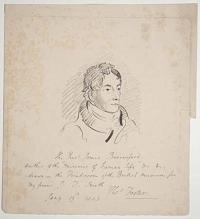
The Rev.d James Berresford Author of the 'Miseries of Human Life' & drawn in the Printroom of the British Museum for my friend J. T. Smith - Tho.s Foster. May 19th 1823.
1823.
Engraving. 205 x 190mm (8 x 7½"). Small margins and torn to plate mark on bottom and lower half of right edges. Foxing across left and upper areas of the sheet.
Head and shoulders portrait of James Beresford (1764-1840), inclined to the right. Beresford was a writer and clergyman. He wrote under a variety of pseudonyms and 'Miseries of Human Life' was his most successful work (published under his true name), a satirical work still considered to be a 'minor classic' of the genre.
[Ref: 53851] £120.00
(£144.00 incl.VAT)
![John Bigg the Dinton Hermit, baptized 22nd April, 1629, buried 4th April, 1696 [...]](img-thumbnail/jpegs/29408.jpg)
John Bigg the Dinton Hermit, baptized 22nd April, 1629, buried 4th April, 1696 [...] He was formerly Clerk to Simon Mayne of Dinton, one of the Judges who passed sentence on King Charles the first. He lived at Dinton (co. Bucks) in a cave, had been a man of tolerable wealth, was looked upon as a pretty good scholar, and of no contemptible parts. Upon the restoration he grew melancholy, betook himself to a recluse life, and lived by charity, but never asked for any thing but leather, which he would immediately nail to his clothes. He kept 3 bottles that hung to his girdle, viz. for strong and small beer, and milk; his shoes are still preserved; they are very large, and made up of about a thousand patches of leather...
R.L. Fecit.
Published Dec.r 10th 1787, by W.Richardson, at his Antient and Modern Print Warehouse No.174 Strand.
Etching on watermarked paper, 260 x 180mm. (10¼ x 7"). Trimmed to platemark.
It has been suggested that Bigg was Charles I's executioner, given sanctuary and anonymity on one of the regicide's estates. Not in BM.
[Ref: 29408] £190.00
(£228.00 incl.VAT)
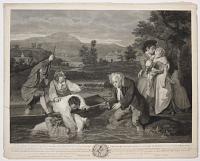
To the Right Hon.ble the Earl of Stamford, President, The Right Hon.ble Lord Beauchamp, M.P. The Right Hon.ble Lord Willoughby de Broke, &c. Vice Presidents, The Stewards & Directors of the Humane Society, This Print of the Body of a Young Man taken out of the Water apparently dead in the sight of his distressed Parents, Is most respectfully Dedicated, by their obliged Humble Servant Robert Pollard.
Painted by Rob.t Smirke. Engraved by Rob.t Pollard.
London, Published March 26th 1787, by R. Pollard Engraver, No 15. Braynes Row, Spa Fields.
Etching and engraving. 495 x 630mm (19¾ x 24¾"). Thread margins, a few small tears, heavy crease through title.
A boy being dragged to the side of a river by men in the water and in a punt, as his mother faints on the river bank. Alongside its pair, 'The Young Man restored to Life', this print was published to raise awareness of the Royal Humane Society, a charity founded in 1774 as 'the Society for the Recovery of Persons Apparently Drowned' to provide life-saving and resusitation services and training. Although the society is still active it has forsaken the 'tobacco smoke enemas' practiced by its founder, William Hawes M.D. (1736-1808)
[Ref: 47698] £380.00

Tychonis Brahe
De L'armessin Sculp
From 'Academie des Science et des Arts', Amsterdam 1682.
Engraving. Sheet 185 x 135mm (7¼ x 5¼"). Trimmed to image and laid on album paper. Light staining across the image.
A half portrait of Tycho Brahe (1546-1601), a Dutch astronomer and nobleman. He observed that the moon orbited the Earth and that the planets orbited the Sun - although still believed the Sun orbited the Earth. He wore a prosthetic nose for much of his life after losing his original in a drunken duel with a cousin.
[Ref: 53793] £160.00
(£192.00 incl.VAT)
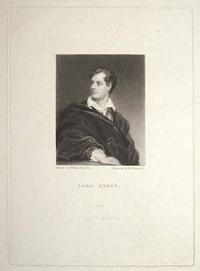
Lord Byron. Proof.
Painted by T. Phillips, engraved by S. W. Reynolds.
Pub.d by T. Phillips, Feb.y 1822.
Fine mezzotint. 230 x 165mm (9 x 6½"), with wide margins.
George Gordon Noel Byron (1788-1824), a British poet and a leading figure in the Romantic movement. He was celebrated in life for aristocratic excesses including huge debts, numerous love affairs, rumours of a scandalous incestuous liaison with his half-sister, and self-imposed exile. He travelled to fight against the Ottoman Empire in the Greek War of Independence, for which Greeks revere him as a national hero. He died at 36 years old from a fever contracted while in Missolonghi, Greece. Engraved from the portrait by Thomas Phillips, which was undertaken as part of a commission by the publisher William Miller to paint the portraits of several poets whose works he published, the intention being to hang them together at Miller's house at 50 Albemarle Street, London. Annette Peach writes of the commission: "In 1813 Murray commissioned from Phillips a portrait of Byron (who brought the publisher more commercial success than any other of his writers), which still hangs over the drawing-room fireplace in Albemarle Street. The half-length view famously shows a pale-complexioned Byron in a white shirt with a large turned-down ‘Byronic’ collar open at the neck to reveal his throat, and wrapped in a dark cloak. The dress and pose are identical to that of Charles Mayne Young in his portrait by G. H. Harlow (1809; Garrick Club, London), where the actor is portrayed as Hamlet, and it is possible that Byron saw Young perform this role. As in his portrait of Blake, Phillips's ability to convey the Romantic (and here self-dramatizing) cast of his sitter's imagination indicates that, although his œuvre is less flamboyant than that of his contemporary Sir Thomas Lawrence, he, too, was quintessentially a Romantic painter." One of several engravings made from Phillips' portrait. Whitman: 45
[Ref: 53855] £260.00
(£312.00 incl.VAT)
![Lord Byron [ms]](img-thumbnail/jpegs/34946.jpg)
Lord Byron [ms]
[possibly by J.S. Agar, 1814]
Line engraving on india, proof before letters, with very large margins; platemark 220 x 180mm (8¾ x 7"). Tipped into album sheet.
George Gordon Noel Byron (1788-1824), British poet and archetypal Romantic figure. Byron was celebrated in life for aristocratic excesses including huge debts, numerous love affairs, rumours of a scandalous incestuous liaison with his half-sister, and self-imposed exile. He travelled to fight against the Ottoman Empire in the Greek War of Independence, for which Greeks revere him as a national hero. He died at 36 years old from a fever contracted while in Missolonghi, Greece. Engraved from the portrait by Thomas Phillips, which was undertaken as part of a commission by the publisher William Miller to paint the portraits of several poets whose works he published, the intention being to hang them together at Miller's house at 50 Albemarle Street, London. Annette Peach writes of the commission: "In 1813 Murray commissioned from Phillips a portrait of Byron (who brought the publisher more commercial success than any other of his writers), which still hangs over the drawing-room fireplace in Albemarle Street. The half-length view famously shows a pale-complexioned Byron in a white shirt with a large turned-down ‘Byronic’ collar open at the neck to reveal his throat, and wrapped in a dark cloak. The dress and pose are identical to that of Charles Mayne Young in his portrait by G. H. Harlow (1809; Garrick Club, London), where the actor is portrayed as Hamlet, and it is possible that Byron saw Young perform this role. As in his portrait of Blake, Phillips's ability to convey the Romantic (and here self-dramatizing) cast of his sitter's imagination indicates that, although his œuvre is less flamboyant than that of his contemporary Sir Thomas Lawrence, he, too, was quintessentially a Romantic painter." One of several engravings made from Phillips' portrait. O'D 27?; For a larger version of the same image see ref. 34943.
[Ref: 34946] £120.00
(£144.00 incl.VAT)
![[George, Lord Byron]](img-thumbnail/jpegs/34944.jpg)
[George, Lord Byron]
T. Phillips R.A. pinxit. C. Warren sculpsit.
[c.1824]
Line engraving on india with very large margins, proof before title; 270 x 170mm (10½ x 6¾"). Tipped into album sheet.
George Gordon Noel Byron (1788-1824), British poet and archetypal Romantic figure. Byron was celebrated in life for aristocratic excesses including huge debts, numerous love affairs, rumours of a scandalous incestuous liaison with his half-sister, and self-imposed exile. He travelled to fight against the Ottoman Empire in the Greek War of Independence, for which Greeks revere him as a national hero. He died at 36 years old from a fever contracted while in Missolonghi, Greece. Engraved from the portrait by Thomas Phillips, which was undertaken as part of a commission by the publisher William Miller to paint the portraits of several poets whose works he published, the intention being to hang them together at Miller's house at 50 Albemarle Street, London. Annette Peach writes of the commission: "In 1813 Murray commissioned from Phillips a portrait of Byron (who brought the publisher more commercial success than any other of his writers), which still hangs over the drawing-room fireplace in Albemarle Street. The half-length view famously shows a pale-complexioned Byron in a white shirt with a large turned-down ‘Byronic’ collar open at the neck to reveal his throat, and wrapped in a dark cloak. The dress and pose are identical to that of Charles Mayne Young in his portrait by G. H. Harlow (1809; Garrick Club, London), where the actor is portrayed as Hamlet, and it is possible that Byron saw Young perform this role. As in his portrait of Blake, Phillips's ability to convey the Romantic (and here self-dramatizing) cast of his sitter's imagination indicates that, although his œuvre is less flamboyant than that of his contemporary Sir Thomas Lawrence, he, too, was quintessentially a Romantic painter." Not in O'D; For a larger version of the same image see ref. 34943.
[Ref: 34944] £120.00
(£144.00 incl.VAT)
![Lord Byron after Phillips, 1831 [ms in lower margin]](img-thumbnail/jpegs/34947.jpg)
Lord Byron after Phillips, 1831 [ms in lower margin]
[possibly by R. Woodman]
Line engraving on india with very large margins, platemark 210 x 150mm (8¼ x 6"). Proof before letters; tipped into album sheet.
George Gordon Noel Byron (1788-1824), British poet and archetypal Romantic figure. Byron was celebrated in life for aristocratic excesses including huge debts, numerous love affairs, rumours of a scandalous incestuous liaison with his half-sister, and self-imposed exile. He travelled to fight against the Ottoman Empire in the Greek War of Independence, for which Greeks revere him as a national hero. He died at 36 years old from a fever contracted while in Missolonghi, Greece. Engraved from the portrait by Thomas Phillips, which was undertaken as part of a commission by the publisher William Miller to paint the portraits of several poets whose works he published, the intention being to hang them together at Miller's house at 50 Albemarle Street, London. Annette Peach writes of the commission: "In 1813 Murray commissioned from Phillips a portrait of Byron (who brought the publisher more commercial success than any other of his writers), which still hangs over the drawing-room fireplace in Albemarle Street. The half-length view famously shows a pale-complexioned Byron in a white shirt with a large turned-down ‘Byronic’ collar open at the neck to reveal his throat, and wrapped in a dark cloak. The dress and pose are identical to that of Charles Mayne Young in his portrait by G. H. Harlow (1809; Garrick Club, London), where the actor is portrayed as Hamlet, and it is possible that Byron saw Young perform this role. As in his portrait of Blake, Phillips's ability to convey the Romantic (and here self-dramatizing) cast of his sitter's imagination indicates that, although his œuvre is less flamboyant than that of his contemporary Sir Thomas Lawrence, he, too, was quintessentially a Romantic painter." One of several engravings made from Phillips' portrait. O'D 28?; For a larger version of the same image see ref. 34943.
[Ref: 34947] £120.00
(£144.00 incl.VAT)

Lord Byron
Painted by T. Phillips, R.A. / Engraved by Edw.d Finden
London, Published by John Murray, 1827
Line engraving on india with very large margins, platemark 190 x 115mm (7½ x 6"). Tipped into album sheet.
George Gordon Noel Byron (1788-1824), British poet and archetypal Romantic figure. Byron was celebrated in life for aristocratic excesses including huge debts, numerous love affairs, rumours of a scandalous incestuous liaison with his half-sister, and self-imposed exile. He travelled to fight against the Ottoman Empire in the Greek War of Independence, for which Greeks revere him as a national hero. He died at 36 years old from a fever contracted while in Missolonghi, Greece. Engraved from the portrait by Thomas Phillips, which was undertaken as part of a commission by the publisher William Miller to paint the portraits of several poets whose works he published, the intention being to hang them together at Miller's house at 50 Albemarle Street, London. Annette Peach writes of the commission: "In 1813 Murray commissioned from Phillips a portrait of Byron (who brought the publisher more commercial success than any other of his writers), which still hangs over the drawing-room fireplace in Albemarle Street. The half-length view famously shows a pale-complexioned Byron in a white shirt with a large turned-down ‘Byronic’ collar open at the neck to reveal his throat, and wrapped in a dark cloak. The dress and pose are identical to that of Charles Mayne Young in his portrait by G. H. Harlow (1809; Garrick Club, London), where the actor is portrayed as Hamlet, and it is possible that Byron saw Young perform this role. As in his portrait of Blake, Phillips's ability to convey the Romantic (and here self-dramatizing) cast of his sitter's imagination indicates that, although his œuvre is less flamboyant than that of his contemporary Sir Thomas Lawrence, he, too, was quintessentially a Romantic painter." One of several engravings made from Phillips' portrait. Not in O'D; For a larger version of the same image see ref. 34943.
[Ref: 34949] £120.00
(£144.00 incl.VAT)
![[George, Lord Byron]](img-thumbnail/jpegs/34945.jpg)
[George, Lord Byron]
Armstrong sc. [ms]
[Pub. by J. Murray, 1819]
Line engraving on india with very large margins, 235 x 165mm (9¼ x 6¾"). Tipped into album sheet. Manuscript in lower margin: in pencil "Unpublished print by Armstrong only 20 impressions from this plate which was then destroyed".
George Gordon Noel Byron (1788-1824), British poet and archetypal Romantic figure. Byron was celebrated in life for aristocratic excesses including huge debts, numerous love affairs, rumours of a scandalous incestuous liaison with his half-sister, and self-imposed exile. He travelled to fight against the Ottoman Empire in the Greek War of Independence, for which Greeks revere him as a national hero. He died at 36 years old from a fever contracted while in Missolonghi, Greece. Engraved from the portrait by Thomas Phillips, which was undertaken as part of a commission by the publisher William Miller to paint the portraits of several poets whose works he published, the intention being to hang them together at Miller's house at 50 Albemarle Street, London. Annette Peach writes of the commission: "In 1813 Murray commissioned from Phillips a portrait of Byron (who brought the publisher more commercial success than any other of his writers), which still hangs over the drawing-room fireplace in Albemarle Street. The half-length view famously shows a pale-complexioned Byron in a white shirt with a large turned-down ‘Byronic’ collar open at the neck to reveal his throat, and wrapped in a dark cloak. The dress and pose are identical to that of Charles Mayne Young in his portrait by G. H. Harlow (1809; Garrick Club, London), where the actor is portrayed as Hamlet, and it is possible that Byron saw Young perform this role. As in his portrait of Blake, Phillips's ability to convey the Romantic (and here self-dramatizing) cast of his sitter's imagination indicates that, although his œuvre is less flamboyant than that of his contemporary Sir Thomas Lawrence, he, too, was quintessentially a Romantic painter." One of several engravings made from Phillips' portrait. O'D 27; For a larger version of the same image see ref. 34943.
[Ref: 34945] £180.00
(£216.00 incl.VAT)
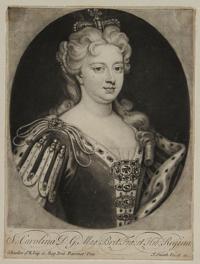
S. Carolina D.G. Mag: Brit: Fra: et Hib: Regina.
G. Kneller S.R. Imp. et Mag. Brit. Baronet.s Pinx.
J. Smith Fec. et ex.
Mezzotint. Plate 203 x 152mm. 8 x 6". Ink stain on left shoulder; false margins added
Caroline, Queen of George II (1683-1737), of Brandenburg-Ansbach. Her parents died while she was still a child and she spent her early life in Berlin, before marrying Prince George of Hanover, the future King George II, in 1705. She accompanied him to England as Princess of Wales in 1714. After Sir Godfrey Kneller (1646 - 1723). CS: 269.ii.
[Ref: 24354] £140.00
(£168.00 incl.VAT)
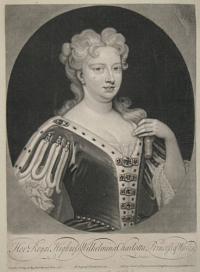
Her Royal Highness Wilhelmina Charlotta Princess of Wales.
G. Kneller S.R. Imp. et Mag. Brit. Baronets. Pinx. 1716. Ab Originali J. Smith Fecit. 1717.
Sold by I. Smith at ye Lyon & Crown in Russell Street Covent Garden -.
Mezzotint. Mounted on an album page. Image 347 x 249mm. 13½ x 9¾". Cut and laid on sheet.
Caroline Wilhelmina of Brandenburg-Ansbach (1683-1737), Queen of George II. Her parents died while she was still a child and she spent her early life in Berlin, before marrying Prince George of Hanover, the future King George II, in 1705. She accompanied him to England as Princess of Wales in 1714. This plate was retitled when she became queen and then reworked to add a crown and pearl necklace. From the Belton House Collection assembled in the 18th Century by the Rt. Hon. John Ld. Brownlow, Baron Charleville, & Viscount Tyrconnel in the Kingdom of Ireland. Ex: Collection of The Hon. C. Lenno
[Ref: 12834] £150.00
(£180.00 incl.VAT)

Her Royal Highness the Princess of Wales. O Dea Certe. No longer shall ye widow'd Land bemoan, A broken Lineage, and a doubtful Throne...Already for th'Illustrious Youths complain, And pity Monarchs doom'd to sigh in vain. Addison. And God said I will bless her, and she shall be a Mother of Nations: Kings of people shall be of her. Gen: Cap.17. v.16
G: Bickham Sculp:
[n.d. c.1780.]
Engraving with very large margins, scarce. Plate 209 x 166mm (8¼ x 6½"). Publication line scratched, creases in margins.
Queen Caroline (1683-1737), Queen of George II, as Princess of Wales. Her parents died whilst she was still a child and she spent her early life in Berlin before marrying Prince George of Hanover in 1705. Provenance: Heritage Hexham.
[Ref: 30108] £240.00
(£288.00 incl.VAT)
![[Edward Collier] Mr Collier's Letter Racks: a tale of art and illusion at the threshold of the modern information age.](img-thumbnail/jpegs/59767.jpg)
[Edward Collier] Mr Collier's Letter Racks: a tale of art and illusion at the threshold of the modern information age.
Dror Wahrman.
Oxford University Press, 2012.
8vo, black cloth gilt with illus. d/w; pp. 275 profusely illustrated.
An account of Edward (or Evart) Collier (1642-1708), a Dutch Golden Age still-life painter known for trompe-l'œil paintings, often based around letter racks and prints. See Ref: 59758
[Ref: 59767] £50.00
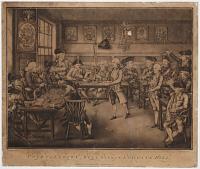
Court of Equity, Bell-Savage Ludgate Hill.
Rob.t Dighton Pinxit. Rob.t Laurie Fecit.
Published Nov.r 1st 1778, by John Smith, Cheapside, London.
Scarce mezzotint. Sheet 360 x 430mm (14¼ x 16¾"). Trimmed to plate, laid on card, extensive cracking and surface rubbing. Damaged.
The interior of a club room, with a convivial group of men drinking and smoking. The motto behind the presiding officer's chair reads 'Mirth with Justice'. Through its lifespan The Bell Savage Inn was an Elizabethan playhouse, the coaching inn where Pocahontas stayed, the home of England's first rhinoceros and John Cassell's publishing house. It was demolished in 1873. George writes: ''The persons are well-characterized portraits. The chairman is 'Hurford, the Guildhall orator' (William Hurford, Deputy of Castlebaynard Ward). On his r., and on the extreme l. are Wright, distiller in Fleet Street, and Hamilton, clerk to William Woodfall, printer, holding the 'Morning Chronicle'. Opposite the latter sits Smith the printseller. On the chairman's l. are (l. to r.), Lamb, silversmith in Fetter Lane; Clark, sausage maker; Stephenson, an attorney; Clark, a bricklayer in Shoe Lane; Russell, a broker of Harp-Alley; Good, the auctioneer; Thorn; Dighton, the artist, on the extreme r. In the foreground (r.) by a small table sits Dighton's father; between the two Dightons is a man reading the 'Morning Post'. In front of him and facing the chairman stands Towse of Vauxhall, speaking, pipe in his l. hand, r. hand thrust in his waistcoat. Pipes, glasses, pots, papers of tobacco, and a punch-bowl are on the tables. Tom Thorpe, of the Globe Tavern, advances in the middle of the room, carrying a punch-bowl''. A rare print: the British Museum has two proof examples, yet George takes the title from Chaloner Smith, 'Court of Equity or Convivial City Meeting' with a date 1779. Apparently neither had seen a titled example. BM Satire: 5530; CS 18. Ex: Collection of the Hon. Christopher Lennox-Boyd.
[Ref: 44334] £280.00
(£336.00 incl.VAT)
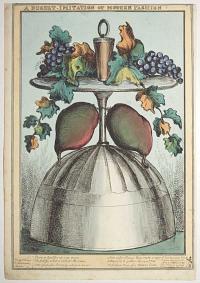
A Desert - Imitation of Modern Fashion!
[Monogram of Paul Pry, pseudonym of William Heath, holding a wine glass]
Pub by T. McLean 26 Haymarket London [n.d., c.1825].
Etching with fine hand colour. Sheet 365 x 255mm (14¼ x 10"). Trimmed into plate on three sides, to printed border at top.
An upturned wine glass represents a woman, with the brim of a hat with grapes as decoration, the bowl her bustle. BM Satires 15611.
[Ref: 59479] £320.00
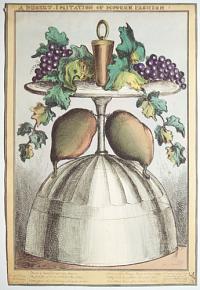
A desert - imitation of modern fashion!
[Monogram of Paul Pry, pseudonym of William Heath]
Pub by T. McLean 26 Haymarket London [n.d., c.1825].
Fine coloured etching. Sheet 355 x 240mm (14 x 9½"). Trimmed into printed border.
An upturned wine glass represents a woman, with the rim the brim of a hat with grapes as decoration, the bowl her bustle. BM Satires 15611.
[Ref: 58276] £260.00
(£312.00 incl.VAT)

Dogs and Still Life.
Jervase Pinxit. Jos.h Farington delin.t. P.C. Canote Sculpsit.
Published March 2.d 1778 by John Boydell Engraver in Cheapside London.
Engraving. Plate: 225 x 270mm (9 x 10½"). Small margins.
A scene showing a pair of dogs attempting to steal some game but a cat manages to get there first.
[Ref: 47475] £80.00
(£96.00 incl.VAT)

Drinking Song. Othello _ Act 2, Scene 3. And Let me the Canakin Clink, link [...]
John P. Knight A.R.A.
[London: The Etching Club, 1843.]
Steel etching on chine collé. 300 x 210mm (11¾ x 8¼").
With two vignettes: a still life of armoured gauntlets and flagons, and five soldiers toasting. One of nine plates in ''Songs of Shakespeare, Illustrated by the Etching Club... Presented to the Subscribers of the Royal Polytechnic Union''.
[Ref: 57551] £60.00
(£72.00 incl.VAT)
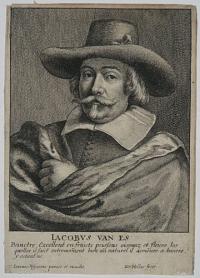
Jacobus van Es Peinctre Excellent en fruicts poissons oiseauz et fleurs les quelles il faict extremement bien au naturel il demeure a Anvers y estant ne.
Joannes Meyssens pinxit et excudit. W. Hollar fecit.
[c.1661]
Etching, in ink verso J.B., sheet 165 x 115mm (6¼ x 4¼"). Trimmed to platemark.
Portrait of Jacob van Es (1606-65/6), Antwerp painter of still life. Pennington: 1399. i or ii
[Ref: 23395] £130.00
(£156.00 incl.VAT)
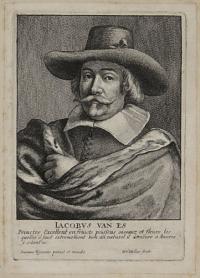
Jacobus van Es Peinctre Excellent en fruicts poissons oiseauz et fleurs les quelles il faict extremement bien au naturel il demeure a Anvers y estant ne.
Joannes Meyssens pinxit et excudit. W. Hollar fecit.
[c.1661]
Etching. Plate 165 x 114mm. 6½ x 4½". Laid on sheet, crease to paper lower left.
Portrait of Jacob van Es (1606-65/6), Antwerp painter of still life. Pennington: 1399. i/iv.
[Ref: 24059] £130.00
(£156.00 incl.VAT)
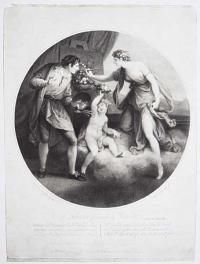
A Flower painted by Varelst. From Prior. When fam'd Varelst this little Wonder drew...
Angelica Kauffman pinx.t. Tho.s Burke fecit.
Published January 1st 1784 by Tho.s Burke, Kemp's Row Chelsea.
Stipple. Plate: 405 x 305mm (16 x 12''). Trimmed to plate on left and right side. Messy.
A tribute to the still-life painter Simon Verelst (c.1644-1721). Thomas Prior's poem on a painting by Verelst is accompanied by an engraving after Kauffman depicting Flora herself lending a hand to the painter's work.
[Ref: 48315] £240.00
(£288.00 incl.VAT)

A Flower painted by Varelst. From Prior. [...] From the Original Picture, in the possession of Geo.e Bowles, Esq.r.
Angelica Kauffman pinx.t. Thomas Burke Fecit.
Publish'd Jan.y 1st 1784 by Tho.s Burke, Kemp's Row Chelsea.
Stipple and etching with large margins. 410 x 310mm (16 x 12¼").
A tribute to the still-life painter Simon Verelst (c.1644-1721). Thomas Prior's poem on a painting by Verelst is accompanied by an engraving after Kauffman depicting Flora herself lending a hand to the painter's work: 'When fam'd Varelst this little Wonder drew; / Flora vouchsaf'd the growing work to view: / Finding the painter's science at a stand, / The Goddess snatch'd the pencil from his Hand; / And finishing the Piece, she smiling said; Behold one work of mine, that ne'er shall fade.'
[Ref: 29791] £320.00

From Still Life to the Screen. Print Culture, Display, and the Materiality of the Image in Eighteenth-Century London.
Joseph Monteyne.
Yale University Press. New Haven London. [2013.]
4to, blue cloth gilt and illust. d/w; pp. x + 280, profusely illustrated, with 55 colour plates.
An account of the culture of popular prints in 18th-century London.
[Ref: 59758] £65.00
![[Set of four fruit prints, presented within separately-printed rococo borders.]](img-thumbnail/jpegs/52949.jpg)
[Set of four fruit prints, presented within separately-printed rococo borders.]
[Fruit after Johann Wilhelm Weinmann.]
[Regensburg: Hieronymus Lentz, 1737-1745.]
Four very decorative engravings, printed in colours and hand-finished, trimmed with horticultural-themed etched borders pasted over. Total printed area 480 x 350mm (19 x 13¾"). Some spotting, worm holes in margins, two plates with fruits named in old ink mss.
Four fine fruit prints in a unique presentation, within identical, near-contemporary extra borders designed for such usage. The same design is printed on the reverse of the sheet. The fruit come from volumes three and four of Weinmann's 'Phytanthoza iconographia', a work famous for the quality of its colour printing. See: Ref 58811
[Ref: 52949] £1,200.00
view all images for this item
![[Game Birds.]](img-thumbnail/jpegs/51074.jpg)
[Game Birds.]
G. Stevens pinx.t et del. Printed by C. Hullmandel.
[n.d., c.1850.]
Fine hand-coloured lithograph. Sheet: 180 x 145mm (7 x 5¾''). Trimmed and laid on album sheet.
A still life showing game birds in a larder.
[Ref: 51074] £140.00
(£168.00 incl.VAT)
![[Still-life with game birds and cats]](img-thumbnail/jpegs/40219.jpg)
[Still-life with game birds and cats] Dedié a S.E.Mr. le Marquis de Chauvelin Ambassadeur de France a Turin D'aprés le Tableau de Benedetto Castiglione haut de onze pouces et large d'un pied neuf pouces [...]
[c.1760][Bit later]
Etching, platemark 250 x 365mm (9¾ x 14¼"). Small margins.
Etching after a painting by Giovanni Benedetto Castiglione (1609-64), Genovese artist of mostly religious subjects, which exploited his gift for animals and still-life elements. This painting was owned by Jacques-Laure Le Tonnelier, balli de Breteuil (1723-85), Maltese diplomat and patron of the arts. The print, in turn, is dedicated to the French ambassador in Turin, the Marquis de Chauvelin. Famous cat image.
[Ref: 40219] £95.00
(£114.00 incl.VAT)
![[A scarce family tree of George I with a prospect of London]](img-thumbnail/jpegs/52508.jpg)
[A scarce family tree of George I with a prospect of London]
[German, c.1720.]
Engraving. 380 x 240mm (15 x 9½"). Paper toned and stain in very large margins.
A genealogy of George I presented as a tree, illustrating his dynastic claim to the throne of Great Britain and Ireland. Behind the tree is a prospect of London from Whitehall to London Bridge, which is still filled with houses.
[Ref: 52508] £450.00
![His Royal Highness The Prince of Wales.&c [&] Her Royal Highness The Princess of Wales.&c](img-thumbnail/jpegs/11680.jpg)
His Royal Highness The Prince of Wales.&c [&] Her Royal Highness The Princess of Wales.&c
G. Kneller Eq: Baronet pinx. 1717 [&] 1716. Geo: Vertue Londini Sculp: 1724.
London Sold by G. Vertue at his house in Brownlow Street. Drury Lane.
Pair of engravings, sheets c.460 x 340mm (18 x 13½"). Trimmed within plates and tipped into album pages.
George II (1683 - 1760) as Prince of Wales and his future queen Caroline Wilhelmina of Brandenburg-Ansbach (1683 - 1737). Caroline Wilhelmina was the daughter of John Frederick of Brandenburg-Ansbach. Her parents died while she was still a child and she spent her early life in Berlin, before marrying George in 1705. She accompanied him to England as Princess of Wales in 1714. A fine pair in oval frames, Caroline a particularly strong impression. After Sir Godfrey Kneller (1646 - 1723).
[Ref: 11680] £480.00
view all images for this item
![[Small Game Birds and a Hare.]](img-thumbnail/jpegs/51075.jpg)
[Small Game Birds and a Hare.]
G. Stevens pinx.t et del. Printed by C. Hullmandel.
[n.d., c.1850.]
Hand-coloured lithograph. Sheet: 180 x 145mm (7 x 5¾''). Trimmed and laid on album sheet.
A still life showing game hanging in a larder. See Ref: 51074
[Ref: 51075] £140.00
(£168.00 incl.VAT)
![[Henry Hare, 2nd Lord Coleraine.]](img-thumbnail/jpegs/34225.jpg)
[Henry Hare, 2nd Lord Coleraine.] Effigiem hanc praenobilis Henrici Heri Baronis de Colerane [...]
[Begun by William Faithorne, finished by George Vertue 1728.]
Engraving, platemark 360 x 225mm (14¼ x 8¾). Excellent impression; trimmed inside platemark
Henry Hare, second Baron Coleraine (bap. 1636-d.1708), antiquary and architect. Coleraine traveled in Italy and translated G.F. Loredano's 'The Ascents of the Soul'. He was also MP for Old Sarum in Wiltshire, although he lived for most of his life in Tottenham, Middlesex (now in London) where he remodelled the family house, Bruce Castle (which still survives as a museum, and which Coleraine is said to haunt). William Faithorne, a contemporary of Coleraine, began this plate, presumably after his own drawing, which was completed much later by George Vertue. Coleraine's grandson Henry, 3rd Baron (1693-1749) was a friend and patron of Vertue. Alexander 579; Fagan p.28 ii/ii; for Faithorne's frontispiece to Hare's translation of 'The Ascents of the Soul', see ref. 14866.
[Ref: 34225] £180.00
(£216.00 incl.VAT)
![[Henry Hare, 2nd Lord Coleraine.]](img-thumbnail/jpegs/34224.jpg)
[Henry Hare, 2nd Lord Coleraine.] Effigiem hanc praenobilis Henrici Heri Baronis de Colerane [...]
[Begun by William Faithorne, finished by George Vertue 1728.]
Engraving with very large margins, platemark 370 x 235mm (14½ x 9¼). Good impression.
Henry Hare, second Baron Coleraine (bap. 1636-d.1708), antiquary and architect. Coleraine traveled in Italy and translated G.F. Loredano's 'The Ascents of the Soul'. He was also MP for Old Sarum in Wiltshire, although he lived for most of his life in Tottenham, Middlesex (now in London) where he remodelled the family house, Bruce Castle (which still survives as a museum, and which Coleraine is said to haunt). William Faithorne, a contemporary of Coleraine, began this plate, presumably after his own drawing, which was completed much later by George Vertue. Coleraine's grandson Henry, 3rd Baron (1693-1749) was a friend and patron of Vertue. Alexander 579; Fagan p.28 ii/ii; for Faithorne's frontispiece to Hare's translation of 'The Ascents of the Soul', see ref. 14866.
[Ref: 34224] £230.00
(£276.00 incl.VAT)
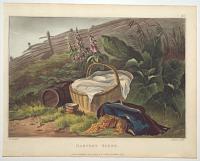
Harvest Scene. 60
D. Cox Del.t. R. Reecve sculp.t.
London, Published June 1823 by S. & J. Fuller, 34, Rathbone Place.
Aquatint, printed in colours and hand finished. Sheet 210 x 270mm (8¼ x 10½"). Trimmed within plate.
A still life of a picnic basket, a keg, a cup and a jacket, under a fence with foxglove growing in the verge.
[Ref: 57502] £95.00
(£114.00 incl.VAT)
![[Head Study.]](img-thumbnail/jpegs/24824.jpg)
[Head Study.]
Original-Radierung Von O. Fischer.
Druck & Verlag Der Gesellschaft E. Verveilf. Kunts in Wien. [n.d. c.1901.]
Etching on wove paper. Plate 310 x 235mm. 12¼ x 9¼".
Head study of a Jew. Otto Fischer (Leipzig, 1807-Dresden 1947) was one of Germany's most famous etchers and painters at the beginning of the twentieth century, Otto Fischer studied at the Dresden Academy, under Preller and Hermann Prell. From 1894 to 1914 Otto Fischer participated in many exhibitions throughout Europe and America. He then assumed the post of Professor of Art at the Dresden Academy. Today the art of Otto Fischer is included in major museums in Berlin, Dresden, Leipzig, Breslau, Budapest and at the Albertina, Vienna. In his etched art, Otto Fischer gained a strong reputation as a superbly talented delineator of landscapes, still-lifes, figure studies and portraits. Head Study is surely a tour de force of Otto Fischer's art. With its finely crafted lines and shadings the artist has rendered the soul of his study. Vervielfaltigende Kunst issued it first original etching in 1871. During the following sixty years it published masterworks by Austrian, German, Czech, Swiss, French, Dutch and English artists. More internationally focused and less conservative than most of its rival publishers, Vervielfaltigende Kunst became a spearhead for the vibrant experiments of Symbolist, Expressionist and Secessionist artists during the initial decades of the twentieth century. Also, its superb printing techniques were second to none. As a result, Vervielfaltigende Kunst is now regarded as a most vital fine art publisher of its day and individual prints from this publication are eagerly sought after on the international market.
[Ref: 24824] £320.00
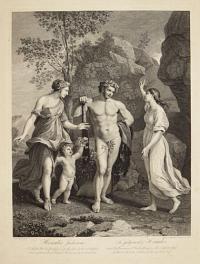
The Judgement of Hercules. From the Painting of Nicolas Poussin, 3 feet high by 2 feet 4 inches Wide, in the Collection of Henry Hoare Esq.r.
Nicolas Poussin Pinx.t. Robertus Strange delin.t et sculp.t Londini 1759.
[London: Robert Strange, 1790.]
Engraving. 510 x 380mm (20 x 15"), with very large margins.
Hercules as a young man, visited by the figures of Vice and Virtue, who offer him the choice between a pleasant and easy life or a severe but glorious life. Hercules, of course, chose the latter. From a collected edition of the engravings by Sir Robert Strange (1721-92) after famous paintings, in this case one by Poussin, c.1636, owned by Henry Hoare (1705-85), a banker and patron of art, who built Stourhead in Wiltshire, where it still resides.
[Ref: 46535] £280.00
(£336.00 incl.VAT)
Unfortunately this item is either sold or reserved. If you are interested in similar items and cannot find what you're looking for on our website, please consider filling in our interests form. If you register, we can also send you items that match your interests when the website is updated.
![[Horse Guards] To the Rt. Hon'ble Viscount Combermere G.C.B. & G.C.H. and the Officers of the 1st Regiment of Life Guards. this Print is most respectfully dedicated by Their Obedient Servants. W. Robert and Lowes Dickinson. &](img-thumbnail/jpegs/6933.jpg)
[Horse Guards] To the Rt. Hon'ble Viscount Combermere G.C.B. & G.C.H. and the Officers of the 1st Regiment of Life Guards. this Print is most respectfully dedicated by Their Obedient Servants. W. Robert and Lowes Dickinson. & [Hyde Park Corner] To the most noble the Marquis of Londonderry, G.C.B. & G.C.H. and the Officers of the 2nd Regiment of Life Guards, this Print is most respectfully dedicated by their obedient Servants, W. Robert and Lowes Dickinson.
[Dated in image 1851 with monogram]
Pair of tinted lithographs with added hand colour, image size 620 x 760mm. Framed. Unexamined out of frames.
Life Guards passing the Wellington Arch at Hyde Park Corner when it still had the Statue of Wellington on the top, and the Entrance to Horse Guards from Whitehall. An extremely scarce pair, in original frames.
[Ref: 6933] £2,600.00
view all images for this item

No 5. Italian Still Life.
Publish'd by H. Lacey, 59 Oxford St London, Jan.y 1830.
Scarce aquatint with very fine hand colour. Sheet 165 x 205mm (6½ x 8"). Trimmed to image on three sides, into plate at bottom.
A table with a coffee cup, spoon, jar of cherries, bowl of plums, wine bottle and potted bush.
[Ref: 53273] £160.00
(£192.00 incl.VAT)

Jack Snipes.
Drawn on Stone by T.H. Lynch, 9, Polygon, Clarendon Square from an Original Picture by T. Oliver.
Published by the Proprietor, 14, Dalston Rise, near Hackney; and to be had of Mess.rs Ackermann & Co, 96, Strand. Printed by Lefevre & Kohler, Newman St
Coloured lithograph, very scarce; printed area 325 x 235mm (12¾ x 9¼"). Slightly time stained.
Unsual still-life with snipes hanging and objects on table.
[Ref: 29704] £320.00
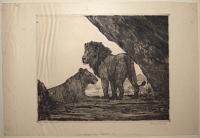
Lion and Lioness. Before cutting down sign & still pacing / 6.
1/60. A Radclyffe Dugmore [pencil signature].
[n.d. c. 1910].
Etching, signed by the artist. 205 x 245mm (8 x 9½"), with large margins. Laid on paper.
A lion and lioness sheltering under a rock by Arthur Radclyffe Dugmore (1870-1955), Welsh-born American naturalist and wildlife photographer, painter, print-maker and author.
[Ref: 54770] £260.00
(£312.00 incl.VAT)
![[Still-Life with Lobster.]](img-thumbnail/jpegs/63169.jpg)
[Still-Life with Lobster.]
[Johann Balthasar Probst.]
[n.d., c.1700s.]
Very rare and fine hand-coloured mezzotint. 385 x 245mm (15¼ x 9¼"), on laid paper, 18th century watermark, with very large margins. Some time-staining, soiling, and handling creases.
Still life of a Lobster, a glass, a tankard and a magnifying glass.
[Ref: 63169] £950.00
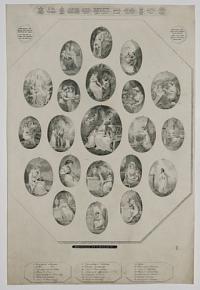
In Heaven as on Earth Eternally United. No Time the Dear Remembrance can Remove. No Time Shall Cancel thy Desert. Ev'n o'er your Marble Tomb my Constant Heart will ever Mourn. He Sleeps in Dust & all the Muses Mourn. The Obvious Ills which Checker Human Life to the Sweet Babe are Happily Unknown. In Silent Sorrow o'er they Tomb I'll Mourn. Why do thou Mourn while he with Kindred Angels Reign. The Feeling Heart alone should Tarry here. In grief of Heart I drop the Dutious Tear. Like a Flower in Early Bloom in Early Bloom she Died. Still shall thy Grave with rising Flowers be Drest and the Green Turf lye lightly on they Brest. Here shall the Morn her Earliest Tears bestow Here the First Rose in the year shall Blow. [Numbered stipple ovals:] 1. Conjugal Sorrow. 2. Dito....D.o. 3. Disappointed Hope. 4. Peace & Love. 5. Friendship & Sincerity...15. Hope. 16. Parental Sorrow. 17. Love & Fidelity. 18. Hope & Sincerity. 19. Maternal Sorrow. 20. Filial Sorrow. 21. Conjugal Sorrow.
Designed by J. Hopkins.
[n.d. c.1797.]
Stipple and etching, rare. Sheet 305 x 204mm (12 x 8").
A collection of oval stipples depicting love, hope, courtship, harmony, friendship, sincerity, fidelity, affection, peace and sorrow.
[Ref: 30459] £160.00
(£192.00 incl.VAT)
![[Life of Aesop: Aesop taken to prison.]](img-thumbnail/jpegs/48710.jpg)


![[Still-life banquet piece]](img-thumbnail/jpegs/45998.jpg)
![[Still-life banquet piece]](img-thumbnail/jpegs/40220.jpg)





![John Bigg the Dinton Hermit, baptized 22nd April, 1629, buried 4th April, 1696 [...]](img-thumbnail/jpegs/29408.jpg)



![Lord Byron [ms]](img-thumbnail/jpegs/34946.jpg)
![[George, Lord Byron]](img-thumbnail/jpegs/34944.jpg)
![Lord Byron after Phillips, 1831 [ms in lower margin]](img-thumbnail/jpegs/34947.jpg)

![[George, Lord Byron]](img-thumbnail/jpegs/34945.jpg)



![[Edward Collier] Mr Collier's Letter Racks: a tale of art and illusion at the threshold of the modern information age.](img-thumbnail/jpegs/59767.jpg)










![[Set of four fruit prints, presented within separately-printed rococo borders.]](img-thumbnail/jpegs/52949.jpg)
![[Game Birds.]](img-thumbnail/jpegs/51074.jpg)
![[Still-life with game birds and cats]](img-thumbnail/jpegs/40219.jpg)
![[A scarce family tree of George I with a prospect of London]](img-thumbnail/jpegs/52508.jpg)
![His Royal Highness The Prince of Wales.&c [&] Her Royal Highness The Princess of Wales.&c](img-thumbnail/jpegs/11680.jpg)
![[Small Game Birds and a Hare.]](img-thumbnail/jpegs/51075.jpg)
![[Henry Hare, 2nd Lord Coleraine.]](img-thumbnail/jpegs/34225.jpg)
![[Henry Hare, 2nd Lord Coleraine.]](img-thumbnail/jpegs/34224.jpg)

![[Head Study.]](img-thumbnail/jpegs/24824.jpg)

![[Horse Guards] To the Rt. Hon'ble Viscount Combermere G.C.B. & G.C.H. and the Officers of the 1st Regiment of Life Guards. this Print is most respectfully dedicated by Their Obedient Servants. W. Robert and Lowes Dickinson. &](img-thumbnail/jpegs/6933.jpg)



![[Still-Life with Lobster.]](img-thumbnail/jpegs/63169.jpg)
